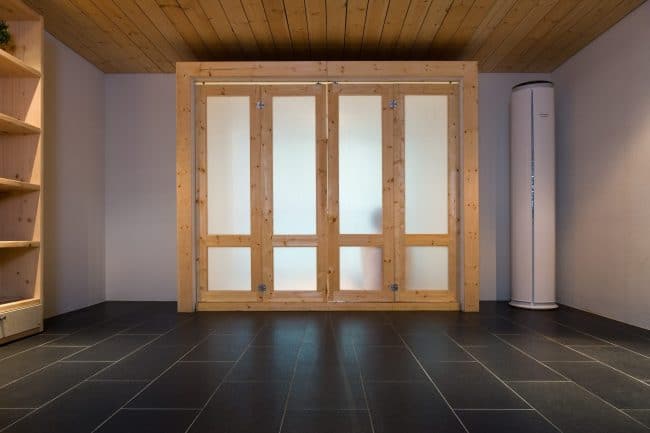#의심1. ‘크기’에 대하여 높이 2.7m의 한정된 구조에서 좀 더 높은 천장을 확보하려는 치열한 싸움의 우열은 4~5cm에서 결정된다. 하지만 나는 확장 노력보다 오히려 더 작고 더 낮은 것을 만들어 기존 것과 경쟁을 시켰다. 크고, 작고, 넓고, 좁음이 절대적 크기가 아닌 상대적 크기에서 오는 심리적 개념이라는 생각에서다. 마치 자신보다 예쁘지 않은 친구를 동반하는 여성들의 심리처럼 말이다. 자체로 예뻐지는 것은 분명 한계가 있기 때문이다.
#의심2. ‘방’에 대하여 애들이 방에서 하는 행위를 살펴보니 크게 ‘논다’, ‘잔다’, ‘공부한다’였다. 그들은 방 안에서 쪼그리고, 서서, 매달려서, 자빠져서, 엎드려서, 마구 처박혀서, 호들갑스럽게, 혼자, 친구랑, 형과, 매달려, 다리 벌리고, 구석에서, 코골고, 헤벌레, 정신없이, 요란하게, 한나절을, 온종일을, 지긋지긋하게 놀고 자고 공부했다.
이처럼 아주 다른 양태가 방 안에서 이루어지고 있었다. 각각의 움직임도 달랐고 빈도, 호흡, 행동반경도 모두 달랐는데 변하지 않는 단 한 가지가 있다면 그것은 공간의 상태였다. 옷만 하더라도 잠옷과 외출복과 작업복을 따로 구분해서 입으면서도 놀고, 자고, 공부하는 다른 행위를 담는 그릇인 방의 상태는 늘 일정하니 이상한 일이다. 방이 그처럼 멀티플(multiple)하단 말인가?
#의심3. ‘앉고 섬’에 대하여 어찌된 노릇인지 이 집 사람들은 소파를 놓고도 그곳에 앉지 않았다. 그들은 거실 바닥에 앉을 때야 비로소 소파를 등받이나 높은 베개로 사용했다. 아버지가 바닥에 누우면 아이들이 덩달아 아버지 배 위에 누웠으며, 의자에 앉을 때도 발을 바닥에 닿게 하기보다 가부좌처럼 자신의 허벅지 위에 올려놓기를 좋아했다. 아파트가 입식 생활이었던가?
#의심4. ‘거실’에 대하여 누구 말처럼 생활의 중심이 거실이라면 거실의 중심에는 텔레비전이 있다. 이것을 삼단 논법으로 연결하면 생활의 중심은 텔레비전이 되는 것이고 텔레비전을 안방으로 옮기면 생활의 중심은 안방이 된다. 이 전제가 힘을 얻는 또 다른 이유는 거실의 위치가 실제적인 중심이 아니라 그저 가운데 있어서가 아닐까 하는 의문이 생겼다. 만약 거실 옆에 마루방을 하나 더 만든다면, 그리고 정현이네 식구들이 그곳에서 실컷 드러눕고 생활한다면 거실은 생활의 중심도 공간의 가운데도 아닌 식당과 마루방의 사이가 되는 것이 아닐까?
이 집은 의심 덩어리인 것이다.
#Doubt 1. About “size” Success or failure to secure a higher ceiling in a restricted height of 2.7m is determined by the difference of 4~5cm. However, I paid more attention to creating smaller and lower things, instead of attempting to extend the size to compete with the existing concepts. My thought was based on the belief that large, small, broad or narrow of a size are the psychological concepts produced by relative sizes, not by absolute sizes. Just like the way women’s mentality to be accompanied by a friend somewhat less pretty than her. This is because there is certainly a limit to becoming beautiful by one’s own efforts.
#Doubt 2. About “room” As I watched what kids do in their rooms, their behaviors can be largely divided into three categories: “play,” “sleep,” or “study.” They spent time in their room sleeping, snoring, hanging down, lying on their stomach, lying on their back, hunkering down, standing up, boisterously, with friends, their siblings or by themselves, and so on.
Totally different behaviors were observed inside these rooms. Their individual movement, as well as frequency and area of activity were all different. But, one thing in common was the situation of the space. Compared with clothes which are divided into pajamas, clothes for going out and work clothes, the spatial situations of rooms for playing, sleeping and studying remained the same.
#Doubt 3. About “sitting down and standing up” Strangely enough, the family members of this house didn’t intend to sit on the sofa even if it was available. They preferred sitting on the floor and using the sofa to lean back against or use it like a high pillow. When the father lays on the floor, the kid followed their father lying on his stomach. They also prefer sitting cross-legged when sitting on a chair. This made me wonder if apartments are meant to be a sedentary lifestyle.
#Doubt 4. About the “Living room” If the living room is the center of life, a TV would be the center of the living room. When applying syllogistic reasoning to this, a TV becomes the center of living. Then, if the TV is moved to a bedroom, the center of living would change to the bedroom. The reason this premise makes sense might be because of the fact that the living room is not a realistic center but location of it is positioned in the center of a house. If another floor room is to be created next to the living room and all the family members can use the space, then does the space between the dining room and floor serve as the living room?
The house is full of mysteries.
http://www.archdaily.com/166964/jung-hyun%E2%80%99s-apartment-kim-jae-kwan/

